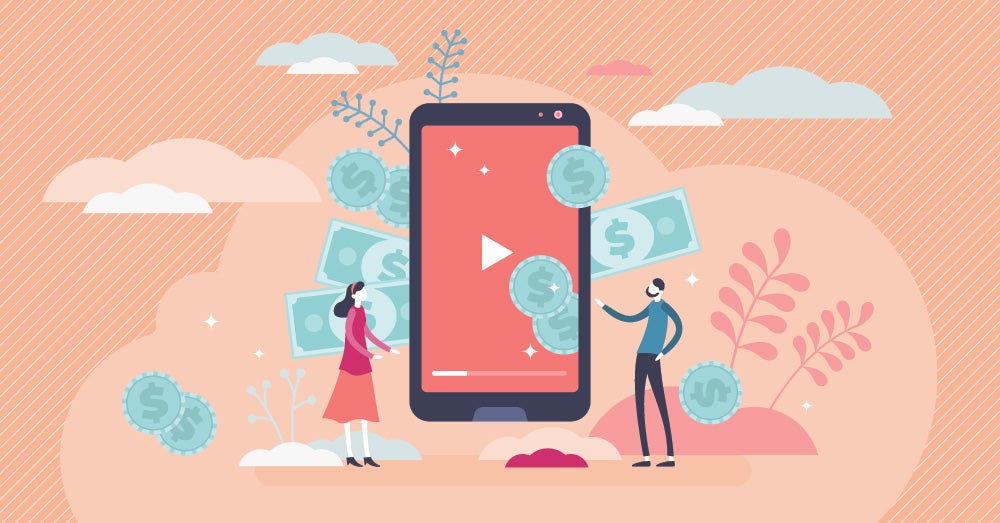
There’s no guidebook to becoming a creator, though here at Passionfruit, we’re trying to change that. Most of us start making things and sharing them purely out of passion. But as your audience grows, the pull to start earning money is an understandable draw. The creator economy calls to all creators eventually.
Pretty soon, your small passion project can become a full-on side hustle. But when do you officially become part of the creator economy? And hey, what is the creator economy anyway?
You might be surprised to learn that you’re likely already part of the creator economy. The real question is how you can make the most of it. Whether you’re a new creator or looking to grow your business, let’s talk about the creator economy and what you can get from it.
What Is the Creator Economy?
When you first hear the term creator economy, it can feel so massive that you might not think of yourself as part of it. That’s a natural feeling, but the efforts of millions of small creators built the economy in the first place.
The term creator economy simply describes the world of creators using digital platforms to promote their creations.
You’re part of the creator economy when you share your first piece of art on Instagram, post a TikTok, or react on YouTube. Before you even think about monetizing your content, you’re in the creator economy. That’s because even if you’re not monetizing your content, the platforms you post on are.
At the moment, every major platform posts ads on or around the content users share. Instagram posts ads between your photos. YouTube runs ads even if you’re not in AdSense. TikTok promotes ads and monetized creators into your feed. So congratulations. You’re already part of the party.
How Big Is The Creator Economy?
In 2022, Adobe, the company behind creation tools like Photoshop, Premiere, and Illustrator, released a Future of Creativity study. According to the report, over 165 million creators joined the creator economy worldwide between 2020 and 2022, and over 34 million new creators entered the space in the United States alone.
The study provides a fascinating look into the creative space of a company whose programs and cloud storage cover millions. At the time, Adobe found that one in four people considered themselves creators.
The ways people contribute to the creator economy are vast, spanning photography, videography, blogging, and music production.
Of the creators polled by Adobe, 48% said freedom of expression was the primary motivation for entering the creator economy. That desire for freedom will be familiar to anyone who’s felt the urge to create for a living.
We all need jobs, but everyone isn’t built to pull a lever, follow a template, or fill out spreadsheets.
Should You Quit Your Job to Focus on the Creator Economy?
No. At least, not until you can make enough money to supplement your original income. And even then, it’s worth considering how much time you spend doing creator work compared to your day job.
There’s no harm in having two income streams; in fact, that’s one of the best ways to ensure you don’t burn out.
One of the biggest issues you’ll face making things for a living is running the risk of growing to resent your passion. Don’t quit your day job until you can make enough to pay your bills and set something aside comfortably.
Don’t take our word for it. Today’s biggest creator, Mr. Beast, says the same thing. In March of 2024, he shared the following on X.
It took Mr. Beast 12 years to grow his channel to its current heights, with 252 million followers and counting. By starting his channel at age 13, Mr. Beast had plenty of time to experiment. Unless you’re starting with someone else paying your bills, you’ll need a job to survive.
Over time, he learned what his audience wanted and how to grow his following. Take your time, and don’t rush into a full-time creator job that will send you into debt. Instead, research how creators you’re inspired by have improved their reach.

Can You Make a Living in the Creator Economy?
According to a 2024 report from LendingTree, one in four businesses in the United States fail within their first year of operation. Most people don’t make a living immediately when they set out to start a new business. However, if you remember that this is a long race and not a sprint, you’ll be better off.
If you want to succeed in the creative economy, you’ll need to be smart and make a plan. It also may require you to think outside the box. To make a living, you don’t need to be a YouTube megastar, TikTok icon, or Instagram influencer. Sure, it helps. But there are other paths to consider.
The biggest roadblock to earning an income in the creative economy is limiting yourself to creating content. Here are some ways to make a living as part of the creator economy.
1) Create a Blog and Sell Ads or Post Affiliate Links
A straightforward way to monetize your content is to add affiliate links to your blog. If you write about movies, add links where people can buy them on Amazon. Maybe you cover home repairs or technology reviews. By joining an affiliate program like CJ, you can link to the products you write about.
This is an easy way to start building revenue as your audience grows. However, affiliate percentages are often low, so you’ll need a lot of sales.
2) Sell A Class
What are you good at? Consider sharing your knowledge base with your followers. If your Instagram builds a big following through knitting, consider holding a knitting class. Whether you’re a photographer, writer, storyteller, home cook, or any other maker, your audience may want to learn from you.
3) Write a Newsletter
Writers who have built a following on platforms like X/Twitter or through blogging should consider starting a newsletter. You can set your rates for a membership or even allow users to read your work for free. Ensure you include a call to action at the end of each post suggesting readers tip. We love the service Ko-fi for easy tipping.
4) Start an Online Store
Whether you paint, make shirts, stickers, posters, or knit teddy bears, you need an online store. People are more likely to buy your goods if you sell them in an online storefront instead of a social media post. You don’t even need to spend money on stock in advance. There are plenty of print-to-order companies.
5) Pitch Your Skills To Local Businesses
Maybe you have a gift for making videos and shooting photos but don’t have a following. The good news is that local businesses need help with their own social media campaigns. Create a package of videos, photos, or story ideas that could help a local business promote its content.
Starting keep your rates reasonable. You can always charge more as you prove the value of your content. Don’t work cheap forever, but remember the value in building a portfolio you can shop to other businesses.
6) Sell Your Work at Local Art and Farmer’s Markets
The creator economy might be primarily online, but that doesn’t mean that’s the only place it lives. Local art and farmers markets are wonderful places to sell your visual artwork, network with other creators, and build your social media following.
Expand Your Vision To Grow Your Business
Most importantly, don’t marry yourself to one concept of how to be a creator. Find your passion and focus on it, but think about every angle it could take.
For example, your Dungeons and Dragons YouTube channel might not make ad money. However, you could sell your viewers copies of the adventures you write. Buttons and stickers have contributed to every band’s gas fund for decades.
Just because you have a main medium for your creative output doesn’t mean it’s all you should have. Remember, the creator economy is an economy. McDonalds doesn’t just sell burgers. Don’t limit yourself to one thing when the market might offer other options.




